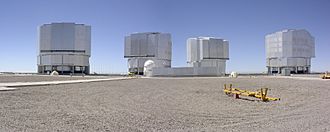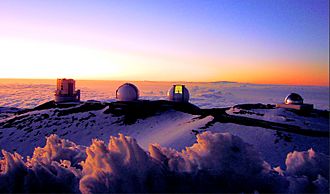Observatory facts for kids
An observatory is a special place where scientists and researchers watch and study different things happening on Earth, in the oceans, or in space. They use observatories to learn about astronomy (stars and planets), meteorology (weather), oceanography (oceans), and even volcanology (volcanoes).
Contents
- Astronomical Observatories: Looking at Space
- Meteorological Observatories: Watching the Weather
- Marine Observatories: Studying the Oceans
- Magnetic Observatories: Earth's Invisible Shield
- Volcano Observatories: Keeping an Eye on Volcanoes
- Images for kids
- See also
Astronomical Observatories: Looking at Space
Astronomical observatories are places built to study the sky. They help us learn about stars, planets, and galaxies. These observatories can be found in four main places: on the ground, in the air, deep underground, or even in space!
Ground-Based Observatories
Ground-based observatories are built on Earth's surface. They are used to observe the sky using radio waves and visible light. Most optical telescopes (which see visible light) are inside a dome. This dome protects the sensitive instruments from bad weather.
The dome usually has an opening that can be opened when scientists are observing. It can also rotate to point the telescope at different parts of the sky. Radio telescopes, which look like giant dishes, usually do not need domes.
To get the best views, optical observatories are often built far away from cities. This helps avoid light pollution from city lights. The best spots have very dark skies, many clear nights, dry air, and are high up. Being high up means there's less air above the telescope, which helps make images clearer.
Some great places for modern observatories include the southwestern United States, Hawaii, the Canary Islands, and the Andes mountains. Famous observatories include Mauna Kea Observatory in the US and Paranal Observatory in Chile. Scientists even found that Ridge A in Antarctica might be the best place on Earth for an observatory because it has very clear skies.
Solar Observatories: Watching Our Sun
Solar observatories are special observatories that focus only on studying our Sun. They use special telescopes to observe the Sun's activity, like sunspots and solar flares.
Radio Observatories: Listening to the Universe
Since 1933, radio telescopes have been used to "listen" to the Universe. They pick up radio waves that come from space. These observatories are also built far from cities to avoid electromagnetic interference (EMI) from things like radios and TVs. Unlike optical observatories, radio observatories can sometimes be placed in valleys. This helps block out even more unwanted signals.
Some major radio observatories include the Very Large Array in New Mexico, USA, and Jodrell Bank in the UK.
Highest Observatories: Closer to the Stars
Many observatories are built at very high altitudes, often above 4,000 meters (13,000 feet). The Mauna Kea Observatory in Hawaii is a famous example, located on a volcano at 4,205 meters (13,796 feet). For a long time, the Chacaltaya Astrophysical Observatory in Bolivia, at 5,230 meters (17,160 feet), was the highest. But now, the University of Tokyo Atacama Observatory in Chile is even higher, at 5,640 meters (18,500 feet)!
Oldest Observatories: A Look Back in Time
People have been observing the sky for thousands of years. Some of the oldest places used for sky-watching include Stonehenge in Great Britain and Chichen Itza in Mexico. These ancient sites show how early humans used the sky to understand their world.
Later, true observatories, which were like early research centers, began to appear. Some of the oldest include the Al-Shammisiyyah Observatory in Baghdad (around 825 AD) and the Maragheh observatory in Iran (1259 AD). The Royal Greenwich Observatory in England, built in 1675, is another famous historical observatory.
Space-Based Observatories: Above the Atmosphere

Space-based observatories are telescopes or other instruments that are launched into outer space, often orbiting Earth. They are amazing because they can see parts of the electromagnetic spectrum that cannot get through Earth's atmosphere. This includes ultraviolet light, X-rays, and gamma rays.
Another big advantage is that their images are super clear because they are above the atmosphere. Earth's atmosphere can make ground-based images blurry. The Hubble Space Telescope is a great example of a space telescope that takes incredibly sharp pictures. However, space telescopes are very expensive to build and hard to fix if something goes wrong.
Airborne Observatories: Flying High

Airborne observatories use airplanes or high-altitude balloons to get above most of Earth's atmosphere. This helps them observe things like infrared light, which is absorbed by water vapor in the air. They are not as high as space telescopes, but they are easier and cheaper to repair and update. The Stratospheric Observatory for Infrared Astronomy (SOFIA) is an example of an airborne observatory that uses a special airplane.
Neutrino Observatories: Deep Underground
Neutrino observatories are built deep underground, underwater, or even under ice. They are designed to detect tiny particles called neutrinos. These particles can travel through almost anything, so placing the observatories deep down helps block out other signals. Examples include the IceCube Neutrino Observatory in Antarctica.
Meteorological Observatories: Watching the Weather
Meteorological observatories, also known as weather stations, are places where scientists study the weather and climate. They collect data on temperature, wind, rain, and other weather conditions. This information helps us understand weather patterns and predict future weather.
Some historical meteorological observatories include the Hohenpeißenberg Meteorological Observatory in Germany (from 1781) and the Hong Kong Observatory (from 1883).
Marine Observatories: Studying the Oceans
Marine observatories focus on observing the oceans. They collect data on things like tides, ocean currents, and even the Earth's magnetic field near the sea. This information is important for ships and for understanding our planet's oceans. The Royal Greenwich Observatory in London, built in 1676, also had a marine observatory role.
Magnetic Observatories: Earth's Invisible Shield
Magnetic observatories measure Earth's magnetic field. This field protects us from harmful radiation from space. These observatories are usually located far from human activity to get accurate readings. They continuously collect data over many years to see how the magnetic field changes.
Volcano Observatories: Keeping an Eye on Volcanoes
A volcano observatory is a place that monitors a volcano and studies its activity. Scientists at these observatories try to understand how volcanoes work and predict when they might erupt. This helps keep people safe in nearby communities. The Hawaiian Volcano Observatory and the Vesuvius Observatory are two well-known examples.
Images for kids
See also
 In Spanish: Observatorio para niños
In Spanish: Observatorio para niños
















